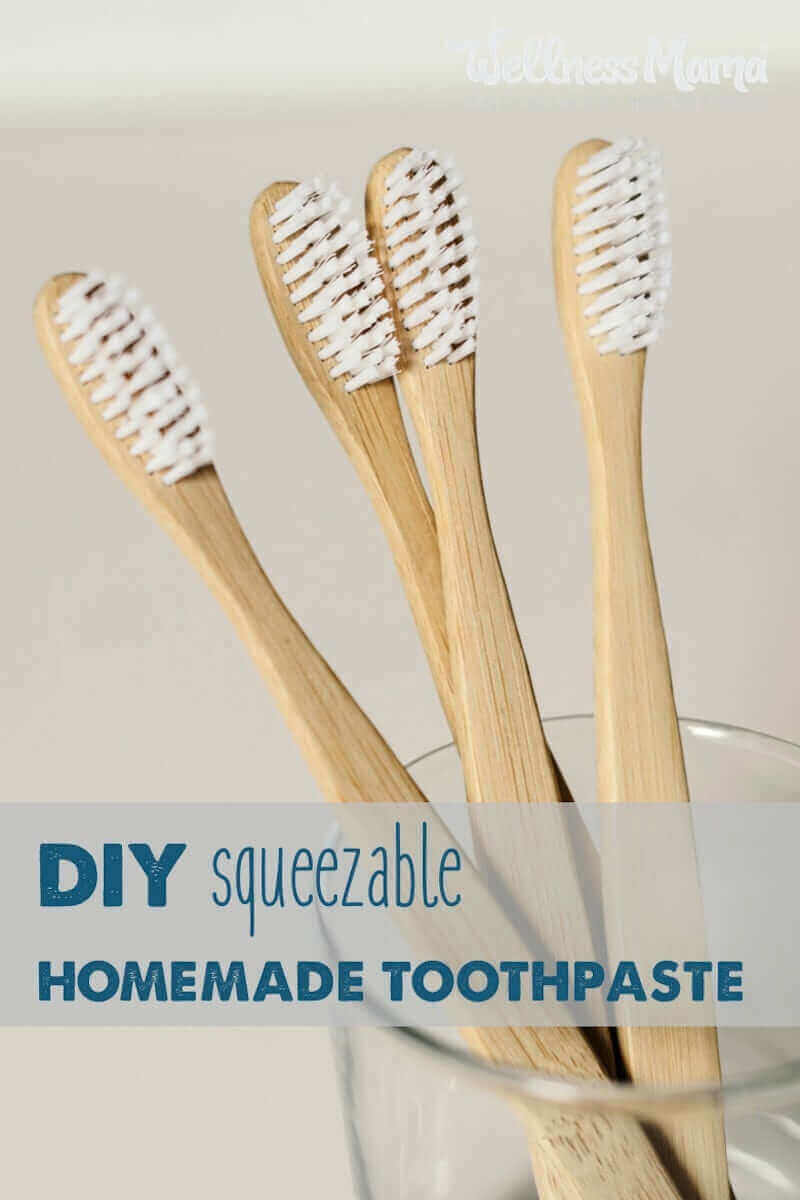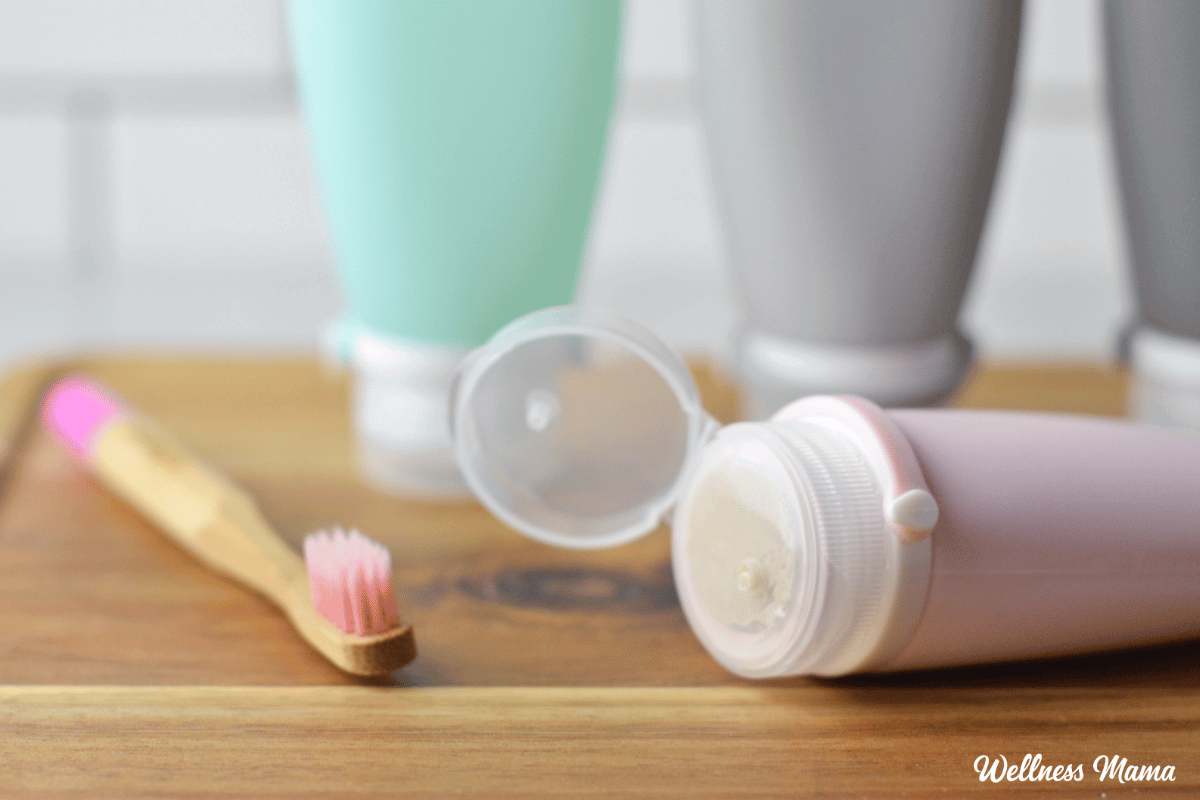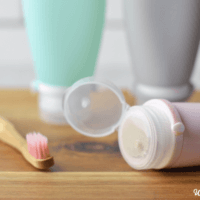My remineralizing toothpaste recipe has always been a big hit, but there were a few problems. It has to be stored in a jar. And thanks to the coconut oil it can get really hard, especially in colder weather. This squeezable homemade toothpaste version solves those problems and gives you a smoother consistency!
You can use distilled water (which does significantly shorten the shelf life) or you can use MCT oil instead. And since it’s in a tube, it’s easier to share than a jar. Don’t feel like making your own? Check out these remineralizing toothpastes from Wellnesse. They come in flavors like mint, cinnamon, and strawberry for the kids.
Squeezable Homemade Toothpaste
Here’s a closer look at the ingredients and how they benefit your teeth.
- Calcium – Our teeth are largely made of calcium, so brushing with it helps us maintain healthy levels. Though diet is also really important!
- Xylitol – This naturally sweet sugar alcohol shows lots of promise for dental health. Studies show it can help reduce plaque and bad bacteria in the mouth. It’s also known to decrease the amount of cavities and can help remineralize cavities.
- Coconut oil – Helps reduce bad bacteria in the mouth that are linked with causing tooth decay and gum disease. It may also help with fresher breath.
- Baking soda – Gently scrubs teeth clean and helps whiten. It can also reduce plaque and supports a healthy mouth pH. Too much can cause gum irritation, which is why I like including it along with other ingredients.
- Bentonite clay – Optional, but has lots of minerals to support enamel. It also helps detox the mouth by adsorbing heavy metals.
- Trace minerals – Helps further strengthen enamel by providing it with more of the minerals it needs.
Adding Essential Oils
These add a pleasant taste as well as antibacterial and anti-fungal properties. Be sure to only use high quality essential oils that are safe to put in the mouth. These include cinnamon, clove, myrrh, peppermint, spearmint, sweet orange, fennel, and tea tree. Some oils are more irritating than others (like cinnamon and clove) so you don’t need as much if using these.
Here’s how to make your own squeezable toothpaste!
Squeezable Homemade Toothpaste Recipe
Equipment
- Food processor (optional)
Materials
- ⅓ cup calcium carbonate powder
- ¼ cup coconut oil (at room temperature)
- 2 TBSP bentonite clay (optional, or more calcium carbonate)
- 3 TBSP MCT oil (or distilled water)
- 30 drops essential oils (such as mint, cinnamon, etc.)
- 20-30 drops trace minerals (optional)
- 3 TBSP xylitol powder (optional)
- 1 TBSP baking soda (optional)
Instructions
- Mix all of the ingredients except clay in a mini-food processor and mix well to incorporate.
- Once smooth, slowly add in the bentonite clay and mix by hand with a non-metal utensil (bentonite clay should not come in contact with metal). If you don’t have a food processor, you can use an immersion blender or even a whisk/fork in a bowl. Do not use an air-tight blender like a magic bullet as this creates too much pressure
- Store in a small glass jar or a squeezable tube.
- Use as you would regular toothpaste.
Notes
- Because of the coconut oil, this toothpaste will be thicker when cooler and thinner when it’s warm. However it should be a squeezable consistency at normal room temp (70-75 degrees). If it’s too runny or too thick, try adding more liquid or calcium.
- Adjust the essential oils to taste.
More Oral Care Recipes
If you’re a fan of making your own oral care products, then I’ve got plenty of recipes to try!
- Natural toothpaste (with coconut oil, baking soda, and essential oils)
- Remineralizing tooth powder (great for travelling with!)
- Natural whitening toothpaste (with charcoal)
- Herbal homemade mouthwash
- Coconut oil pulling chews
Homemade Toothpaste FAQs
Q. What’s the best type of calcium/calcium magnesium to use?
I tried many types of calcium and calcium magnesium powders and got feedback from dozens of readers. The consensus is that calcium carbonate is the best option. Certain types of calcium and magnesium powders can cause issues…like explosive reactions.
Q. Is this okay for sensitive teeth/fillings/veneers/children/etc?
Always check with a dentist before changing a dental routine especially if you have any dental conditions. My kids and I have both used this, including on my teeth that have some non-amalgam fillings (before I knew about remineralization). Since all ingredients are generally considered safe for consumption, I feel comfortable using it, but check with your dentist if you have any doubts.
Q. What are some common reactions in the first few weeks (heightened sensitivity for some)?
I didn’t have any reactions, but it seems some people experience sensitivity for the first few weeks using homemade toothpaste. Especially if they’ve been using commercial products for a long time or have had recent fluoride treatments as the clay can bind and pull out toxins. This seems to be less of an issue with calcium powder and seems to resolve itself within a few weeks. However, check with a holistic dentist if you have specific concerns with your situation.
Q. Xylitol vs. stevia, which is better?
This is largely a matter of opinion. There are studies showing xylitol is very beneficial for oral health, but it is highly toxic for dogs. Be very careful to keep it out of reach of any pets! I use this birch derived, non-GMO xylitol.
Q. Vodka vs. Water?
This recipe works just fine with water, but many people have successfully used vodka in its place to extend the shelf life. MCT oil is an even better option that does not introduce any water into the toothpaste. Microbes can start to grow within days in water based products.
Q. Why NO Glycerin?
There’s some evidence glycerin may inhibit mineral absorption on enamel. While the research is definitely not conclusive on the subject, I feel safer avoiding it just in case. On a personal level, I’ve seen relatives’ teeth turn brown after using glycerin-based toothpaste and return to normal after switching to different brands.
Q. Other than yourself and your family, has anyone else used this for a while?
I’ve received dozens of emails from people who have used this toothpaste or my regular remineralizing toothpaste with good results.
Tina offered these changes:
I started adding a bit of hydrogen peroxide to mine. That made it squeezable. I do not use the bentonite clay. Instead I use baking soda. I also add a few drops of grapefruit seed extract to mine. There is still the fact that coconut oil is more firm in cooler temps.
Melinda adds:
This recipe really does make my teeth look and feel fantastic. I love it! May have to get a squeezable tube and see how that goes.
Q. I had bleeding gums the first few times I used this, is this normal?
I didn’t experience this personally, but have heard from many readers who did. It’s likely from the baking soda, which has a high pH and can irritate the gums in some cases. Some reported experiencing irritated gums for a few days or up to a few weeks which eventually resolved itself. You can always reduce or omit the baking soda if that’s the case.
Q. What type of container is best for this?
I use GoToobs which are made with FDA approved silicone. They’re great for re-using, traveling, and squeezing without worrying about plastic leaching into the toothpaste. I’ve had one of these and for over a year and it’s still going strong. I also use them for my oil cleansing blend when traveling since they don’t leak.
Ever made your own toothpaste or oral health products? How did it go? Share below!




Leave a Reply